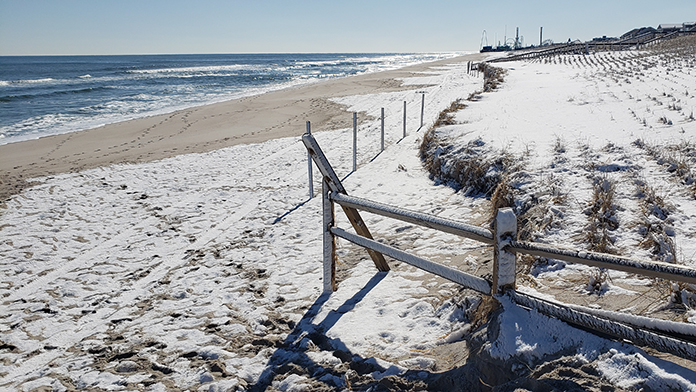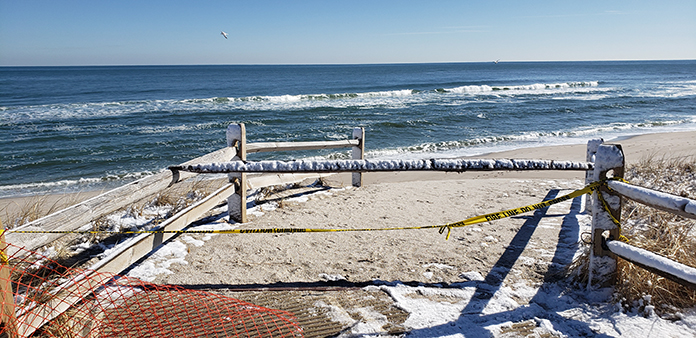
OCEAN COUNTY – The winter forecast has raised cause for concern for not only public safety on the roads but for the damage sustained to the Jersey shore coastline.
Recent storms have left behind as much as three feet of snow in the northwestern portion of the Garden State, while strong winds and waves have eaten away at some beaches.
Waves reached up to 12 feet in height and carved away beach areas causing drop-offs of 10 feet or more in Ortley Beach and Bay Head.
This caused severe damage to dune walkovers at numerous sites. Communities blocked off walkways that normally lead down sloped paths to the beach out of concerns for safety. That damage is now slated for repair and restoration before the summer beach season starts.
Governor Phil Murphy announced that the federal government should be stepping up to address the severe erosion in Bay Head and the Ortley Beach section of Toms River as well as other areas that have been identified. The governor said his administration has been in contact with federal officials.
“They are completely exposed right now,” Governor Murphy said noting that this situation is far more serious than the usual sand replenishment that would occur in preparation of the summer beach season. It is also a matter of protection for those communities.
New Jersey Department of Environmental Protection representatives surveyed 81 beach sites from Raritan Bay to the Atlantic coast and Delaware Bay prior to the February 7 storm.

They conducted examinations following the storm as well to discern the degree of damage that occurred, according to NJ State Police Superintendent Colonel Patrick Callahan. He noted that this was a painful lesson learned from Superstorm Sandy in 2012.
U.S. Army Corps Office public affairs representative Steve Rochette stated that each of the beach fill projects in the state would be performed through a partnership with the NJDEP.
The February 7 storm might not meet the parameters to qualify for approval to install sand to areas damaged by what would be considered ‘extraordinary storm events.’
His office in coordination with the NJDEP determines the extent of beach erosion for project areas. Initial information revealed significant erosion to beach berms in addition to dune erosion. That storm does not appear to have met the criteria to qualify according to Rochette despite the visible damage.
Funding for beach nourishment in the county is slated for the 2022 Fiscal Year provided there is sufficient funding for it. In the interim, nourishments and maintenance falls to the NJDEP and the municipalities themselves.
In a report by the NJDEP’s Division of Coastal Engineering, the erosion and damage was described as moderate to major along the northern barrier island.
That report stated that most of the damage was sloped erosion whereas Bay Head and Ortley Beach suffered vertical erosion. The boroughs of Island Heights and Seaside Park also sustained vertical erosion to a smaller degree. Berkeley officials reported much less beach loss on their small section of Atlantic shore, which is located between Seaside Park and Island Beach State Park.
Island Beach State Park sustained more severe damage which caused drive-on access for recreation fishing to be temporarily suspended.
New Jersey Sierra Club Executive Director Jeff Tittel pointed to the damage as another indicator that climate change was real and worsening issues along the ocean.
“We need action and we need it now. We must be able to adapt and adjust so that our coastal communities are prepared for the next storm,” Tittel said. He also criticized the dune replenishment projects that the U.S. Army Corps of Engineers has overseen along the coast, charging they were not “designed properly for sea-level rise and storm surge.”
The dune projects provided the protection they were designed to provide, according to Army Corps officials. Berm projects and dune installation are performed to lessen the risk of storm damages to infrastructure to residences, businesses, boardwalks and streets as well as utility lines.
Federal officials called for help from the Army Corps of Engineers after the recent storm on February 11.
-Chris Lundy contributed to this story







